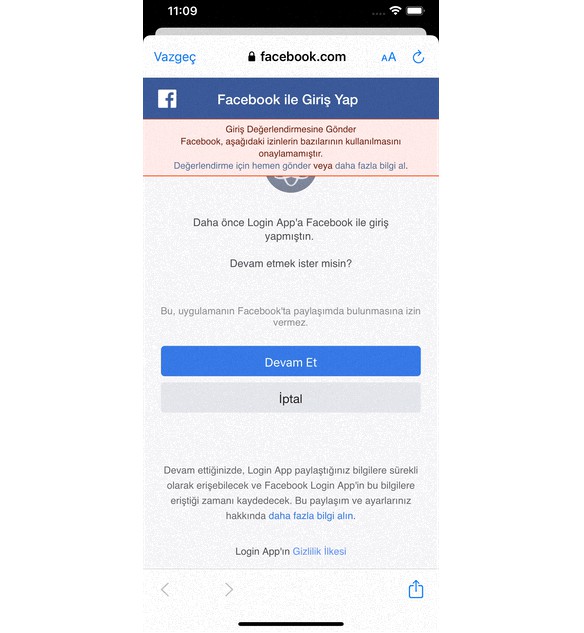Simplicity
Simplicity is a simple way to implement Facebook and Google login in your iOS apps.
Simplicity can be easily extended to support other external login providers, including OAuth2, OpenID, SAML, and other custom protocols, and will support more in the future. We always appreciate pull requests!
Why use Simplicity?
Facebook and Google's SDKs are heavyweight, and take time to set up and use. You can use Simplicity and only have to manage one SDK for logging in with an external provider in your app. Simplicity adds just 200KB to your app's binary, compared to 5.4MB when using the Facebook & Google SDKs.
Simplicity is also extensible, and already supports other login providers, like VKontakte (the largest European social network) and generic OAuth providers.
Logging in with Simplicity is as easy as:
Simplicity.login(Facebook()) { (accessToken, error) in
// Handle access token here
}
Stormpath
Simplicity is maintained by Stormpath, an API service for authentication, authorization, and user management. If you're building a backend API for your app, consider using Stormpath to help you implement a secure REST API. Read our tutorial on how to build a REST API for your mobile apps using Node.js.
Installation
Requires XCode 8+ / Swift 3+
To install Simplicity, we use CocoaPods. To install it, simply add the following line to your Podfile:
pod 'Simplicity'
Carthage
To use Simplicity with Carthage, specify it in your Cartfile:
github "SimplicityMobile/Simplicity"
Swift 2
Older versions of Simplicity support Swift 2.3 (Xcode 8) or Swift 2.2 (Xcode 7).
Add the link handlers to the AppDelegate
When a user finishes their log in flow, Facebook or Google will redirect back into the app. Simplicity will listen for the access token or error. You need to add the following lines of code to AppDelegate.swift:
import Simplicity
func application(_ app: UIApplication, open url: URL, options: [UIApplicationOpenURLOptionsKey: Any]) -> Bool {
return Simplicity.application(app, open: url, options: options)
}
func application(_ application: UIApplication, open url: URL, sourceApplication: String?, annotation: Any) -> Bool {
return Simplicity.application(application, open: url, sourceApplication: sourceApplication, annotation: annotation)
}
Usage
Simplicity is very flexible and supports a number of configuration options for your login providers. To view, please see the full API docs on CocoaDocs.
Using Facebook Login
To get started, you first need to register an application with Facebook. After registering your app, go into your app dashboard's settings page. Click "Add Platform", and fill in your Bundle ID, and turn "Single Sign On" on.
Finally, open up your App's Xcode project and go to the project's info tab. Under "URL Types", add a new entry, and in the URL schemes form field, type in fb[APP_ID_HERE], replacing [APP_ID_HERE] with your Facebook App ID.
Then, you can initiate the login screen by calling:
Simplicity.login(Facebook()) { (accessToken, error) in
// Handle access token here
}
By request, you can also call .login on any LoginProvider:
Facebook().login { (accessToken, error) in
// Handle access token here
}
Using Google Login
To get started, you first need to register an application with Google. Click "Enable and Manage APIs", and then the credentials tab. Create an OAuth Client ID for "iOS".
Next, open up your App's Xcode project and go to the project's info tab. Under "URL Types", add a new entry, and in the URL schemes form field, type in your Google iOS Client's iOS URL scheme from the Google Developer Console.
Then, you can initiate the login screen by calling:
Simplicity.login(Google()) { (accessToken, error) in
// Handle access token here
}
Using VKontakte Login
To get started, you first need to create an application with VKontakte.
After registering your app, go into your client settings page.
Set App Bundle ID for iOS to your App Bundle in Xcode -> Target -> Bundle Identifier (e.g. com.developer.applicationName)
Finally, open up your App's Xcode project and go to the project's
info tab. Under "URL Types", add a new entry, and in the URL schemes form
field, type in vk[CLIENT_ID_HERE]. Then, you can initiate the login
screen by calling:
Simplicity.login(VKontakte()) { (accessToken, error) in
// Handle access token here
}
Generic OAuth Provider
Simplicity supports any OAuth provider that implements the Implicit grant type.
let provider = OAuth2(clientId: clientId, authorizationEndpoint: authorizationEndpoint, redirectEndpoint: redirectEndpoint, grantType: .Implicit)
Simplicity.login(provider) { (accessToken, error) in
// Handle access token here
}
Requesting Scopes for OAuth Providers
If you need custom scopes, you can modify the Facebook or Google object to get them.
let facebook = Facebook()
facebook.scopes = ["public_profile", "email", "user_friends"]
Simplicity.login(facebook) { (accessToken, error) in
// Handle access token here
}
Twitter, LinkedIn, and GitHub
We can't implement Twitter, GitHub, LinkedIn, Slack, or other login types because we can't do authorization_code grants without a client secret. Client secrets are fundamentally insecure on mobile clients, so we need to create a companion server to help with the authentication request.
If this is something you'd like to see, please +1 or follow this GitHub Issue to create a companion server so I know that there's demand for this.


